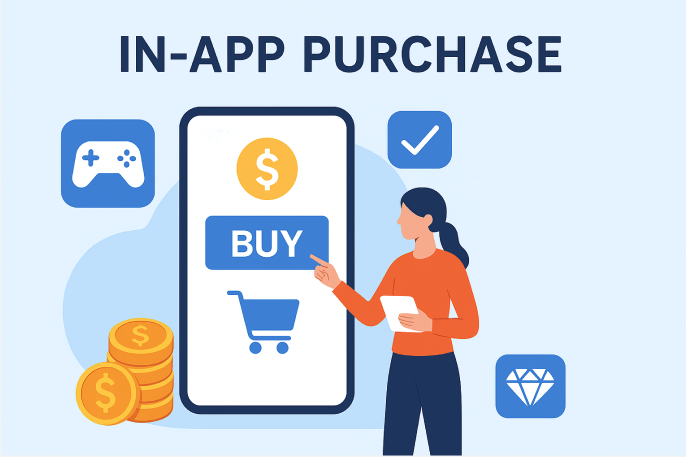Table of Contents
1. introduction – How to successfully monetize your app
Anyone who develops an app usually wants to earn money with it – be it through one-off purchases, subscriptions or other models. One particularly common form of monetization is In-App Purchases (IAP)where users purchase digital content or functions directly in the app.
What many people don’t know: Apple (App Store) and Google (Play Store) usually require the use of their own IAP systems for paid digital content. External payment providers such as Stripe or PayPal may not be used in these cases.
It is therefore essential to legal framework and technical requirements for in-app purchases before planning and implementing a monetization model. This article explains what rights and obligations arise from the Apple and Google guidelines, what types of in-app purchases there are – and how you can integrate them into your app in a sensible and user-friendly way.
2. what are in-app purchases anyway?
In-app purchases are purchase options within an app. Users can purchase content or functions directly in the application – without leaving the app. These purchases are processed via the Apple App Store or Google Play Store platforms.
Types of in-app purchases:
- Consumable goods (consumables): Content that can be used once, e.g. virtual coins or boosts.
- One-off purchases (non-consumables): Permanent activation, e.g. ad-free use or a premium feature.
- Subscriptions: Regular payments for premium content or ongoing functions.
The difference to external payment options lies in the processing: with in-app purchases, the entire purchase process remains within the app.
3. when are in-app purchases useful – or even mandatory?
In-app purchases are always relevant whenif an app is to generate revenue in any form – be it through individual purchases, subscriptions or feature activations. In many cases, they are not only useful, but even mandatoryif certain conditions are met.
💡 Mandatory for digital goods
Apple and Google generally make the use of in-app purchases mandatorywhen digital content or functions sold directly in the app. These include, among others:
- Memberships & Premium Accounts
- Content in Games or dating apps
- Access to digital courses, coaching or communities
- Job advertisements, job exchanges, e-learning platforms
- Media access (e.g. videos, music, articles, downloads)
🛒 External payments are permitted for “genuine” goods or services
In-app purchases are not mandatory when it comes to real products or services products or services – i.e. when the service is provided outside the app. Examples:
- Ordering food (e.g. pizza, supermarket delivery)
- Mobility services (e.g. e-scooters, car sharing, cab bookings)
- Booking hairdresser appointments, massages, dry cleaning etc.
- Shipping physical goods from a store
🧩 Gray areas & special cases
Particularly with hybrid models – for example, when content is partly digital and partly physical – the classification is often unclear. In such cases, tact is required, even when communicating with Apple or Google.
👉 We have already accompanied many projects with sensitive monetization models and know both the requirements of the stores and the typical pitfalls. If you are unsure whether your business model requires in-app purchases, please contact us directly – We can also support you in your arguments or negotiations with Apple.
4. advantages of in-app purchases
In-app purchases not only generate revenue, but also strengthen user loyalty to an app. If implemented cleverly, the model is very user-friendly and scalable.
Advantages at a glance:
- Increased sales: additional sources of revenue directly in the app
- Customer loyalty: Users invest and stay active longer
- Pricing: Flexible offer depending on needs and target group
- Variety of products: different products or functions can be easily added
5. challenges & risks
As attractive as in-app purchases are for monetization, there are also some challenges that should definitely be taken into account when planning.
💸 Commissions from the app stores
Apple and Google charge commissions on all revenue generated via in-app purchases. The following scales currently apply (as of 2025):
- 15 % commission for app developers with up to 1 million USD annual turnover via IAP (so-called “Small Business Program”)
- 30 % commission from an annual turnover over 1 million USD
- Note: Special regulations or deviating programs are possible depending on the country, app category or store updates – subject to change.
🔍 Strict tests & follow-up requirements
As soon as paid content is offered via an app, Apple and Google often scrutinize the entire app more closely. under the microscope – especially with regard to:
- Transparency of prices and services
- Clarity of the subscription conditions (e.g. term, termination)
- Compliance with local legal requirements (e.g. revocation, data protection)
- Implementation of UI guidelines for purchase processing
Especially with subscription models or sensitive content, there may be follow-up requests or queries in the testing process. These often lead to Delays in publication or updates.
⚠️ User criticism of non-transparent models
Frustration can also arise on the user side – especially if:
- Subscription traps or automatic renewals are not clearly communicated
- Content behind unexpected paywalls
- there are unclear pricing models or a lack of contact options
A clearly communicated and comprehensible monetization model is therefore not only crucial for the stores, but also for user trust.
6 How does the technical integration of in-app payments work?
If you want to integrate in-app purchases, you have to use the interfaces from Apple (StoreKit) or Google (Billing Library). Both systems offer extensive functions, but differ in some details.
Technical implementation steps:
- Integration of the respective platform APIs
- Structure of the backend for purchase processing
- Connection to the user account for purchases & recovery
- Sandbox tests for all purchase scenarios
- Testing by Apple/Google in the review process
A special focus should be placed on security (e.g. purchase verification via server) and a stable error handling should be placed. Especially with recurring payments (subscriptions) usually require a own server backend is usually requiredin order to:
- check the current subscription status regularly
- Correctly record renewals, terminations or chargebacks
- Dynamically adjust user rights (e.g. when a subscription expires)
If this logic is missing, this can lead to incorrect activations, unintentional loss of function or problems with the store check.
7. comparison of Apple IAP vs. Google IAP
Both platforms have clear guidelines as to which content may be sold via in-app purchases – and which may not.
Differences & specifications:
- Apple is stricter in its checks, allows fewer external payment services
- IAP use is mandatory for digital content (e.g. premium functions, media)
- External payments are permitted for physical products or services (e.g. ordering food)
Special cases such as logins with paid content or hybrid apps must be checked carefully in advance.
8. best practices from real projects
We know from experience: Many mistakes can be avoided if you follow certain best practices.
Recommendations from the field:
- UX optimization: clear purchasing process, transparent communication
- Pricing: Fair, comprehensible and well justified
- Technology & testing: Extensive testing before going live
- User communication: clearly list subscription conditions, revocation & contact options
9. alternatives and additions to in-app purchases
Not every app has to be monetized via in-app purchases. Depending on the business model, there are also other options:
- External payments (e.g. Stripe, PayPal):
Only permitted for physical products or servicese.g. food orders, mobility or appointment bookings.
For digital content (e.g. memberships, features, courses) external payment providers are not permitted – The IAP obligation applies here.
- Advertising:
Classic monetization via ads – e.g. Google AdMob or Meta Audience Network – is particularly suitable for free apps with a high reach.
- Affiliate & Sponsoring:
Cooperations, product links or branded content offer additional sources of income.
We have extensive experience with individual payment models – especially in cases where the requirements of Apple and Google specific solutions require.
10. conclusion & recommendation
In-app purchases offer an excellent opportunity to operate apps profitably – if they are well planned and properly implemented. Questions such as target group, pricing, technology and legal aspects should be considered at an early stage.
Our tip: Get advice early on and develop a sustainable monetization concept together with experts.
👉 We would be happy to check together which model is sensible and permissible for your app including support in coordinating with the platform operators.



